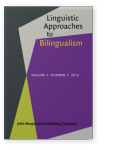Commentary
Different speakers but same Language Acquisition Device?
Jan H. Hulstijn | Amsterdam Center for Language and Communication (ACLC), University of Amsterdam
Article outline
- What are the implications for LAD?
- Level of education effects
- Comparison of L2-performance with L1-performance
-
References
References (6)
References
Chomsky, N. (1965). Aspects of the theory of syntax. Cambridge, Mass: MIT Press.
Grosjean, F. (1998). Studying bilinguals: Methodological and conceptual issues. Bilingualism: Language and Cognition, 11, 131–149. 

Hulstijn, J.H. (2011). Language proficiency in native and nonnative speakers: An agenda for research and suggestions for second-language assessment. Language Assessment Quarterly, 81, 229–249. 

Hulstijn, J.H. (2012). The construct of language proficiency in the study of bilingualism from a cognitive perspective. Bilingualism: Language and Cognition, 151, 422–433. 

Hulstijn, J.H., S, Andringa, N., Olsthoorn, C., Van Beuningen, & R. Schoonen. (submitted). Speech processing in native speakers as a function of age and level of education: What do adult native speakers have in common? Manuscript, University of Amsterdam.
Mulder, K., & Hulstijn, J.H. (2011). Linguistic skills of adult native speakers, as a function of age and level of education. Applied Linguistics, 321, 475–494. 

Cited by (2)
Cited by two other publications
Howard, Martin
2024.
Second Language Acquisition and Language Education—Bidirectional Synergies between Research and Practice.
Education Sciences 14:4
► pp. 345 ff.

This list is based on CrossRef data as of 21 october 2024. Please note that it may not be complete. Sources presented here have been supplied by the respective publishers.
Any errors therein should be reported to them.
